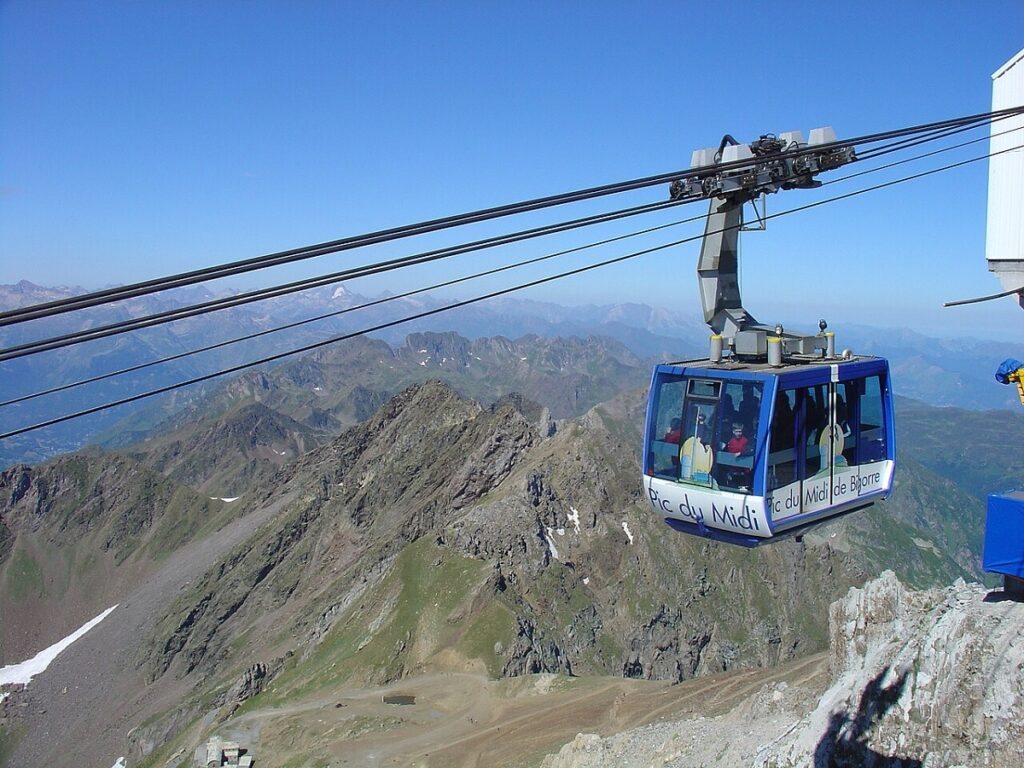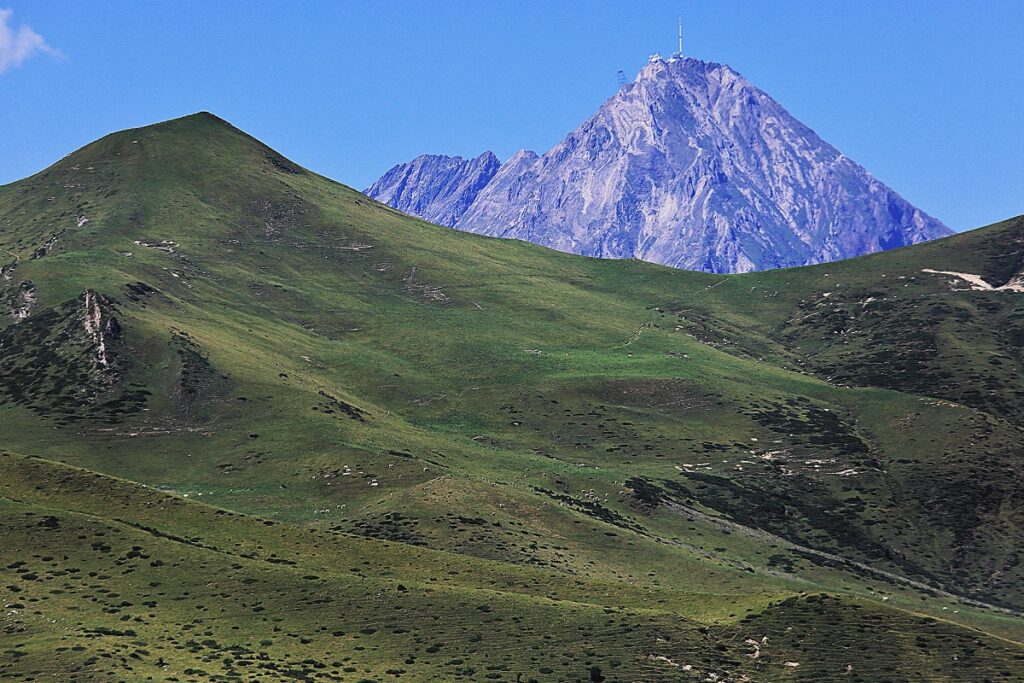Are you going to the Hautes-Pyrénées? Discover our guide to visiting the Pic du Midi!
Located in the Hautes-Pyrénées, the Pic du Midi de Bigorre is one of the 129 main peaks in the Pyrenees mountain range, a natural balcony that acts as a border between France and Spain. Reaching an altitude of 2,877 metres, the Pic du Midi straddles the communes of Sers and Bagnères-de-Bigorre.
It is most famous for the astronomical observatory overlooking its summit. It has been prized by mankind since ancient times, and is steeped in history and mythology – but that’s not all! Astronomy enthusiasts come here in search of pure air, exceptional light, nights free of light pollution and a very stable atmosphere that is ideal for astronomical observations. Visiting the Pic du Midi and climbing it is undeniably one of the must-dos in the French Pyrenees. Climbing to the top of this massif allows you to dominate the immensity of the natural landscape and enjoy breathtaking views just a few minutes away by cable car.
Frequented since the Neolithic period, the summit has been a site for astronomical observations since the 18th century. With our modern facilities, it has become a place to relax, an invitation to calm and serenity. It can be reached either by cable car or by foot (for the more sporty). But that’s not all!
History of the Pic du Midi

Known and coveted since ancient times, man has always been fascinated by the ascent of the Pic du Midi, which was difficult at the time.
Legend has it that the Pyrenees are the tomb of Pyrenea, who died from loving Heracles too much. Heracles chose the Pyrenees as the site of his tomb. According to this legend, Python, a mythical snake born of their love and guarding the tomb, has its head in Gavarnie and its tail at the Pic du Midi.
In the 19th century, the summit of the Pic du Midi was topped by a meteorological station dedicated to research. Scientists wanted to gain a precise understanding of the Earth’s magnetism, atmospheric physics, glaciology and seismology. Given the quality of the sky, the astronomical observatory was founded in 1882. Since then, the site has kept pace with technological developments and continues to serve as a scientific observation post. Initially reserved for scientists, the ascent represented an unparalleled challenge.
🔗 Read Also: 10 Best things to do in Toulouse for first time visitors
Threatened with closure by the State in 1994, the Pic du Midi Observatory was finally saved. In 1996, the Midi-Pyrénées region set up a joint association to install a new cable car that would be available to the general public. The site opened to tourists in 2000. All year round, a cable car transports passengers from La Mongie to the summit of the peak, changing cabins at an altitude of 2,314 metres. It is now the highest museum in Europe. A major scientific site that has become a sporting and cultural attraction, it was awarded the label of National Natural Site in 2003.
What to see and do at the Pic du Midi?
Ascending the Pic du Midi: Cable Car Journey and Hiking Trails

To visit the Pic du Midi, you can take the cable car up the mountain. The first journey leaves from La Mongie – at the foot of the famous Col du Tourmalet. The cable car takes you to the intermediate station at Le Taoulet, at an altitude of 2,341 metres. The first section is 1.781 kilometres long, with a difference in altitude of 556 metres. A second cabin, on the opposite platform, takes you to the Pic du Midi and offers an even more spectacular flight of over 2.6 kilometres above the mountains, with a second drop of 551 metres. Little by little, the observatory comes into view: the summit of the Pic du Midi. You arrive at the cable car station, at an altitude of 2,877 metres, after an extraordinary journey through the air and over the snowfields.
🔗 Read Also: Guide to visit Toulouse Cité de l’espace: tickets, prices, opening times
It is also possible to make the ascent on foot, for the more sporty hikers. Access is via the muleteers’ path, the historic route for visiting the Pic du Midi. This was the route taken by the builders of the observatory. They used porters to transport supplies and materials. The porters carried loads of up to 40 kilos in sometimes spartan conditions. The hike is 20 kilometres long and has a 1,700 metre ascent. In other words, it promises to be a tough one! There are two other possible trails:
- the Col du Tourmalet (800 metres ascent, 13.4 kilometres round trip and 2h30 ascent)
- the Cabane de Toue (950 metres ascent, 13 kilometres round trip, 2h45 ascent).
Experiences at the Summit: Panoramic Views and Unique Attractions
Direct access to the panoramic terraces is open to the public. They offer breathtaking views of the Pyrenees mountain range. On a clear day, you can even see the foothills of the Massif Central, to the north-east of the Occitanie region. Panoramic tables help you identify the peaks in front of you, and other interpretation tables provide information about the environment of the massif.
There’s even a coronograph so you can watch the sun without hurting your retina! In February 2018, a unique viewpoint was opened. Be careful, you’ll need to have your heart set on it. It’s a 12-metre-long pontoon bridge in the void. Don’t worry too much: you’re walking on a glassed-in, completely transparent promontory. You won’t be risking anything, but we guarantee you’ll break out in a cold sweat. At the end of the promontory there’s a slab of glass several centimetres thick, on which visitors will walk over 1,000 metres of vacuum!
🔗 Read Also: 16 Best things to do in Montpellier for first time visitors
Inside, the Pic du Midi restaurant offers a taste of the region’s culinary specialities and local produce. It’s the perfect place for an unusual meal, at an altitude of almost 3,000 metres. The magic is guaranteed with the massif as a backdrop. An experience area is open to all visitors wishing to discover the scientific history of the observation site. The museum highlights the climatic events at the Pic du Midi, the night-time landscapes, and above all the difficulty and challenge faced by 19th-century man to build an observatory on this peak so hostile to man.

How to get to the Pic du Midi?
The nearest airports for flying in from Paris or other destinations are Tarbes and Pau. For the best flights, choose to land at Toulouse-Blagnac with the Skyscanner comparator.
To visit the Pic du Midi by car, take the A64 from Toulouse to exit 14 for Tournay/Bagnères-de-Bigorre. Follow Bagnères-de-Bigorre on the D20. The D918 takes you south to the foot of the La Mongie cable car station.
From Biarritz and Pau, take the A64 to exit 12 towards Tabes-ouest, and follow the D940 to Lourdes, towards Argeles-Gazost, Luz Saint-Sauveur, then Barèges and La Mongie. Note that the Col du Tourmalet is only open from June to November.
🚘 Rent your rental vehicle in Toulouse from €11 per day!
Don’t have a car? Opt for car-sharing! Buses and shuttles run from Bagnères-de-Bigorre to La Mongie every day until the resort closes (€2 per journey, €4 return). From Tarbes, take line 944 towards La Mongie at Tarbes SNCF station. The journey takes 1 hour 35 minutes.
Timetable and fares for the Pic du Midi
Timetable
The Pic du Midi is open all year round!
TOURS: LA MONGIE > PIC DU MIDI
- First departure: 9.30 am
- Last departure: 15:30
- Last return from Pic du Midi: 5pm
FREERIDE SKIING : LA MONGIE > TAOULET
- First departure : 9h30
- Last departure : 16h30
SKI FREERIDE : LA MONGIE > PIC DU MIDI
- First departure : 9h30
- Last departure: 4pm
SUNSETS
- Last departure : 17h
- Last return from Pic du Midi :
- 18h on Tuesdays, Wednesdays and Thursdays from 26 Dec. 2023 to 04 Jan. 2024.
- 7.30pm on Tuesdays, Wednesdays and Thursdays from 13 Feb. to 07 Mar. 2024.
Please note Timetable subject to change depending on attendance, weather conditions, sporting or cultural events.
Prices
- Adults: €49,
- Children under 18: €30,
- Children under 5: free,
- Reduced rate (students, people with reduced mobility, jobseekers): €44,
- Planetarium supplement: €10.




